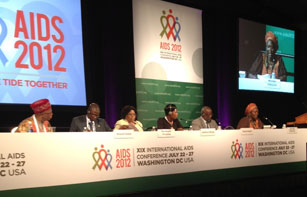
Members of the High-Level panel participating in the session to assess progress made against AIDS and challenges remaining. Washington DC, 26 July 2012. Credit: UNAIDS
How have countries across sub-Saharan Africa fared in responding to the HIV epidemic? What further actions are needed to reach the goal of universal access to HIV prevention, treatment, care and support in the region? These were among the key questions addressed by a high-level panel of African leaders at the XIX International AIDS Conference in Washington DC.
The co-chairs of the panel session—Robert Soudre, President of the Society for AIDS in Africa, and Morolake Odetoyinbo, Chief Executive Officer of Positive Action for Treatment Access, a Nigerian non-governmental organization—noted in their opening remarks the significant strides in reducing new HIV infections and expanding access to HIV treatment across the continent.
Over the past decade, the rate of new HIV infections has declined by more than 25% in 22 countries of sub-Saharan Africa. An estimated 6.2 million people in the region were receiving antiretroviral therapy in 2011—up from just 100 000 in 2003. The most dramatic progress was seen in South Africa, where at least 300 000 people were newly enrolled in HIV treatment in 2011 alone.
Effective prevention programmes are an unfailing vehicle that will take us to the elimination of mother-to-child transmission and to zero new HIV infections among children
Madame Penehupifo Pohamba, First Lady of Namibia and Chair of the Organization of African First Ladies against HIV/AIDS
Jackline Akinyi Odongo, Mentor Mother with the Mothers2Mothers peer-support group at the Nyanza Provincial Hospital in Kenya, described her despair when she found that she was HIV positive and pregnant. She joined the support group, followed guidelines for prevention of mother-to-child transmission of HIV, and took her antiretroviral medications regularly. Her daughter was born HIV-negative.
Madame Penehupifo Pohamba, First Lady of Namibia and Chair of the Organization of African First Ladies against HIV/AIDS, highlighted the considerable gains in reducing new HIV infections among children. About 300 000 children were newly infected with HIV in sub-Saharan Africa in 2011—a 26% decline since 2009. However, more than 90% of children living with HIV globally continue to reside in sub-Saharan Africa.
Madame Pohamba called for strengthening the African ladies' role in promoting the elimination of new HIV infection among children by 2015. “Effective prevention programmes are an unfailing vehicle that will take us to the elimination of mother-to-child transmission and to zero new HIV infections among children,” she said.
Alioune Gueye, President of the West African Youth Leadership Network for the Millennium Development Goals, emphasized the critical role that youth can play in the continent’s HIV prevention revolution. “Young people are at the centre of the AIDS epidemic and youth-led initiatives deserve encouragement and support at the national and international level,” said Mr Gueye.
Between 2001 and 2010, HIV prevalence declined among young people (aged 15-24) in at least 21 of 24 countries with a high HIV burden. However, an estimated 2 400 new HIV infections occur each day in this population.
Organized by the Sub-Saharan Africa Work Group of the AIDS 2012 conference, the High-Level panel also sought to identify set of practical solutions to bring about progress across health and development. Speaking on behalf of the UNAIDS Executive Director, Dr Djibril Diallo, UNAIDS Senior Advisor and Chair of the Sub-Saharan Africa Work Group, emphasized that cooperation between UNAIDS, the African Union and the New Partnership for Africa's Development (NEPAD) led to adopting the landmark roadmap on shared responsibility and global solidarity at the AU Summit this month.
He noted that the Roadmap promotes African-owned solutions which will reinforce the response to AIDS; defines clear goals, expected results and defines role and responsibilities for each stakeholder; and is structured around three pillars: health governance, diversified financing and access to medicine.




